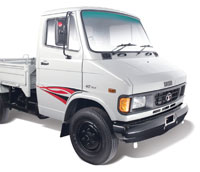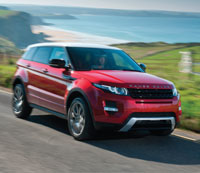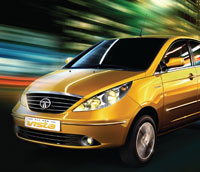|
|
| Corporate Overview >> WINNERS FROM TATA MOTORS |
Home |
|
|
Tata 407
With close to 75% market share, the 407 enjoys about 55% first-time owners, reinforcing self-employment. Since its launch 25 years ago, the 407 has sold over 500,000 units. Launched in 1986, the Tata 407 family contributes seven out of every 10 vehicles sold in the Light Commercial Vehicle (LCV) category in India. The Tata 407 was among the first in the LCV category, which was designed for Indian markets, characterised by overloading, inhospitable terrains, focus on fuel efficiency and low operating costs. The 407 platform was extended to meet diverse needs of goods and people movement.
|
Since its launch 25 years ago, the 407 has sold over 500,000 units. |
 |
|
|
 |
The Evoque uses natural and recycled materials, resulting in low energy demand and minimal carbon footprint. |
Evoque
The Evoque is the smallest, lightest and most fuelefficient
Range Rover model till date. It uses natural and
recycled materials, resulting in substantially low energy
demand and minimal carbon footprint. Contemporary
styling and plentiful personalisation opportunities
makes Evoque a preferred vehicle on road. Since going
on sale, the Evoque has won over a 100 awards
worldwide for exceptional design, performance and
technology, including Top Gear Car of the Year, World
Design Car of the Year and North American Truck of the
Year. The car has seen retail sales of over 50,000 units in
the first six months since its launch.
|
|
|
| The Tata Ace, India's first four-wheel mini truck changed the face of sub 1-tonne goods-carriage in India. |
 |
Ace
With the Ace line of trucks, Tata Motors created a new segment in the CV category - the Small Commercial Vehicle (SCV). The SCV segment targeted three-wheeler drivers, who aspired to graduate to the quality and safety of four-wheelers. The Ace offers superior safety, versatile performance in varied conditions, ease-of-maintenance, style, comfort and cost-effectiveness. Launched in 2005, the Tata Ace, India's first four-wheel mini truck changed the face of sub 1-tonne goods-carriage in India forever. It sold 100,000 in its first 20 months.
|
|
|
 |
The Safari catalysed the SUV segment with its rugged looks and contemporary styling. |
Safari
Released in 1998, the Tata Safari was the country's first premium, indigenous thoroughbred 4-door Sports Utility Vehicle (SUV), designed, developed and manufactured entirely in India. The Safari got a huge response from car owners, becoming very popular in India. It catalysed the SUV segment with its rugged looks and contemporary styling, adding luxury to powerful off-road capabilities. Designed to provide superior passenger comfort, the Safari cabin features extra legroom, high seating and plush interiors, making it an easy drive on and off the road.
|
|
|
|
Indica
The Tata Indica, India's first indigenously made passenger car, was built to deliver on the promise of 'More car per car'. It set standards for interior space and value for money. As a hatchback Indica was originally intended to be a single-user car. It was adapted to fit Indian needs, i.e. to be a chauffeur-driven, family car. Indica's engineering created room for three people in the back seat, provided extra leg space, and fitted a robust rear suspension system. As a result, the Indica has become a best-selling car in some of the most competitive hatchback markets worldwide.
|
The Indica has become a best-selling car in some of the most competitive hatchback markets worldwide. |
 |
|
|
|
Nano
The Nano provides a safe and affordable alternative to two and three-wheeler owners in India. The lowest cost passenger car in the world, the price of the Nano was optimized by reducing the amount of steel used in its construction. Launched in 2009, the car was hailed as a path-breaking initiative, creating the Micro compact segment in the Indian Passenger Car industry. A refreshed version of the Nano was launched in 2012, equipped with a more powerful engine and a greater fuel efficiency of 25.4 km per litre, improving its record as India's most fuel efficient petrol car.
|
 |
The lowest cost passenger car in the world, the price of the Nano was optimized by reducing the amount of steel used in its construction. |
| |
|
| Top |
|
|
|
